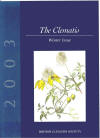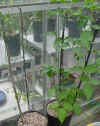


Archive 2003
Images and articles not directly concerned with the main information on the site. Click on small images to enlarge.
You can access any article or image even before the thumbnail image loads, you don't need to wait, just click on the item. Scroll down to earlier dates.
Seedlings come back quickly... even by the post-Christmas period:
(Madame Marie Boisselot x C. texensis) seedling.
Book review, by Mike Brown,
 past Chairman of British Clematis Society. When the image has
loaded, you can click on the enlargement icon, at bottom right. The review can
also be found in the BCS Journal for Winter 2003:
past Chairman of British Clematis Society. When the image has
loaded, you can click on the enlargement icon, at bottom right. The review can
also be found in the BCS Journal for Winter 2003:

Next year's brand-new large-flowered hybrids are ready now. The total is just 44 plants, at this stage. Some of the current year's vines have been retained - they will often produce early flowers in the new season, from this old wood. Most of this present foliage will rot away in the next few weeks as winter comes in.
Plants from the root, again, this is C. koreana in the pot.
C. ochroleuca germinates after 219 days.

This year I've been very lucky with a new meclatis seedling. number P177; first flowers.
Item 1st September, 2003
A large flowered hybrid, or is it?

Four nicely-rooted cuttings of C. florida species.

Item 1st August 2003
Flashback to June, General Sikorski begins to flower within host
Philadelephus.
Further new viornae-types: seedling G52B


Season is 95% curtailed due to keyhole surgery to fix my right arm: www.shoulderdoc.co.uk
http://www.orthoteers.co.uk/shoulderdoc/info/info_rct.htm Thank goodness for keyhole surgery.
Further new viornae-types:
New seedling G111
New seedling G107A
 flowering sequence to follow.
flowering sequence to follow.
Some new viornae-group seedlings' first flowers.
Good year for the viornae. Several more to follow.
New seedling first flowers.
Many more to follow! See table below.
Germination of CC3944 = C. grata? Mustang, Himalaya.
Germination after 89 days.
Exciting germinations of unidentified (in the field) C. species from the Himalaya:
A good week for germinations: you can spot C. macropetala, C. speciosa, and C. 'unknown species'?
It should have been beautiful. Thankfully there are live buds present, so hopefully the plant should live to flower another day. Seedling G66G succumbs to a mystery ailment when just producing first flowers:
Looking really good..............looking very sad. (Grown as) patens form, seed from Japan.
Other victims below.
Total disaster as 57 out of 59 new large-flowered hybrid seedlings are ravaged by mystery ailment.
Bad ones
 Survivor, but only just, on left;
Survivor, but only just, on left;
 better one on right
better one on right
Item April 17th 2003
More germinations, this time C macropetala.
C. macropetala, white form? Seed from Marie-France Holt in Canada. Germination after 56 days.
What is visible when seeds germinate?
C. speciosa - germinations after 47 days. Thanks to Marie-France Holt in Canada for the seed.
Item 2nd April 2003 and 4th April and 6th April
1. Cutting of new atragene T143 flowers opening.
2. Cuttings received by post prior to Winter soon shoot again once spring arrives. You know they are happy once they produce new growth from the soil, and you should (last photo - the leaves are not mildewed! What you can see is dried anti-fungal spray on the leaves!) then prune the plant.
1. Resilience and the will to live. The G47 seedling series has been a superb batch of new seedlings as can be seen on other pages on the site. However, this particular seedling (seedling number G47M) from the batch seemed lost when in October last year it developed a seemingly totally intractable fungal problem and died off. Even worse, in spring, following failure to re-emerge, examination of the largely-dead root system revealed the ominous presence of the worst thing in the world, VINE WEEVILS. However, as Kate Bush said, "don't give up". On February 5th the plant was treated again with two different fungicides, followed by a dose of a new chemical weevil killer; and, after a further six weeks, this is what greeted me this morning, when I decided to check some old pots...
 during clean-up:
during clean-up:
 after clean-up:
after clean-up:

2. New atragene clematis seedling no. T167 first flowers eagerly anticipated, due to open in the next few days.
Flashback to February 18th - pruning a young (second year) Blue Angel. For Group 3 plants remove everything virtually down to the ground. You can leave some bits of stem as a location marker. Group 3 plants grow back from the ground every year, and flower only on the current season's shoots.
1. Last year's old dead vines 2. A close-up 3. After a prune and tidy 4. At March 29th
It doesn't matter if you happen to break a vine while tending a younger seedling; the side shoots immediately below will break out and replace it.
This cutting has produced an additional shoot straight from a root - the shoot has then been re-positioned so that it can quickly see the light; so there'll be two new plants instead of one.
C. coactilis, brand new plant, producing first flowers, in the greenhouse. Thank you Carol Lim of Broomhall PA.
Plant emerging from soil 4th February:

20th March '03 30th March '03 31st March '03
2nd April 4th April
New viticella seedlings, and others, on the way to producing their first ever flowers:
New germinations 'Snow Queen' x C. texensis and 'Mme Marie Boisselot' x C. texensis.
Germination time 447 days. C. texensis all-red form. Photos prior even to 'cotyledons' opening.
A friend calls over to watch the pruning.
Article: "The Scarlet Lady and some of her Relations"
Josephine query - photo of blooms on three years old plant.
Planted 1/05/1999; picture, June 7th, 2002
C. anshunensis flowers begin to open:
Plant received as a cutting, from Japan. An evergreen plant, and needing a slightly protected situation. C. anshunensis is from Sub-genus Campanella, Section Campanella. In Grey-Wilson it is name-changed to C. clarkeana and C. anshunensis has become a synonym.
End of Archive 2003